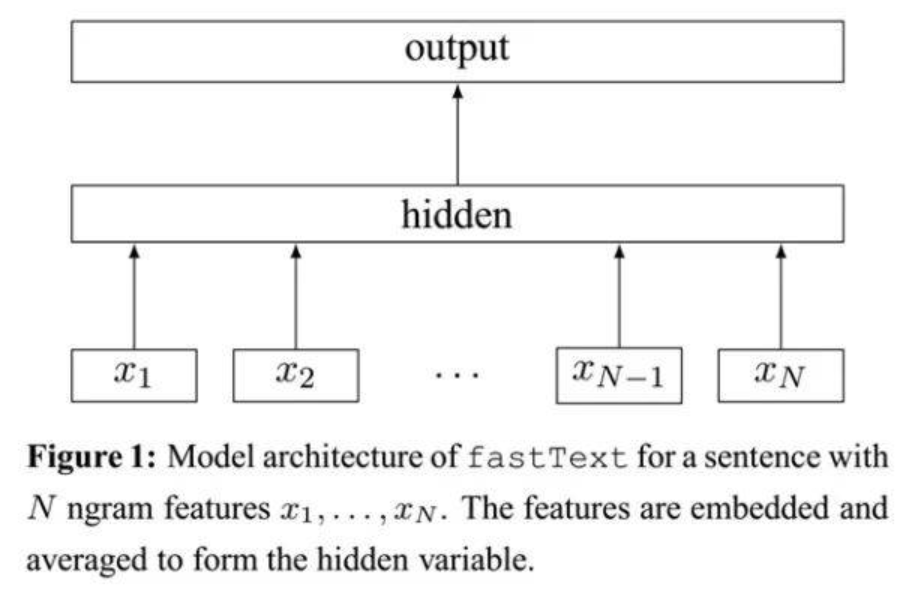基于深度学习的文本分类应用!
每日干货 & 每月组队学习,不错过
作者:罗美君,算法工程师,Datawhale优秀学习者
1. 数据及背景
2. fastText模型剖析
2.1 概念
FastText是一种典型的深度学习词向量的表示方法,它的核心思想是将整篇文档的词及n-gram向量叠加平均得到文档向量,然后使用文档向量做softmax多分类。这中间涉及到两个技巧:字符级n-gram特征的引入以及分层Softmax分类。
2.2 模型框架
fastText模型架构和word2vec的CBOW模型架构非常相似。下面是fastText模型架构图:
注意:此架构图没有展示词向量的训练过程。可以看到,和CBOW一样,fastText模型也只有三层:输入层、隐含层、输出层(Hierarchical Softmax),输入都是多个经向量表示的单词,输出都是一个特定的target,隐含层都是对多个词向量的叠加平均。
不同的是,CBOW的输入是目标单词的上下文,fastText的输入是多个单词及其n-gram特征,这些特征用来表示单个文档;CBOW的输入单词被onehot编码过,fastText的输入特征是被embedding过;CBOW的输出是目标词汇,fastText的输出是文档对应的类标。
值得注意的是,fastText在输入时,将单词的字符级别的n-gram向量作为额外的特征;在输出时,fastText采用了分层Softmax,大大降低了模型训练时间。
2.3 字符级别的n-gram
word2vec把语料库中的每个单词当成原子的,它会为每个单词生成一个向量。这忽略了单词内部的形态特征,比如:"apple" 和"apples","达观数据"和"达观",这两个例子中,两个单词都有较多公共字符,即它们的内部形态类似,但是在传统的word2vec中,这种单词内部形态信息因为它们被转换成不同的id丢失了。
为了克服这个问题,fastText使用了字符级别的n-grams来表示一个单词。对于单词"apple",假设n的取值为3,则它的trigram有:
"<ap", "app", "ppl", "ple", "le>"
这带来两点好处:
对于低频词生成的词向量效果会更好。因为它们的n-gram可以和其它词共享。
对于训练词库之外的单词,仍然可以构建它们的词向量。我们可以叠加它们的字符级n-gram向量。
2.4 分层softmax
-
文本分词后排成列做输入。 -
lookup table变成想要的隐层维数。 -
隐层后接huffman Tree。这个tree就是分层softmax减少计算量的精髓。
3. 简单实现fastText
-
训练词向量时,我们使用正常的word2vec方法,而真实的fastText还附加了字符级别的n-gram作为特征输入; 我们的输出层使用简单的softmax分类,而真实的fastText使用的是Hierarchical Softmax。
首先定义几个常量:
VOCAB_SIZE = 2000
EMBEDDING_DIM =100
MAX_WORDS = 500
CLASS_NUM = 5
-
VOCAB_SIZE表示词汇表大小,这里简单设置为2000;
EMBEDDING_DIM表示经过embedding层输出,每个词被分布式表示的向量的维度,这里设置为100。比如对于“达观”这个词,会被一个长度为100的类似于[ 0.97860014, 5.93589592, 0.22342691, -3.83102846, -0.23053935, …]的实值向量来表示;
MAX_WORDS表示一篇文档最多使用的词个数,因为文档可能长短不一(即词数不同),为了能feed到一个固定维度的神经网络,我们需要设置一个最大词数,对于词数少于这个阈值的文档,我们需要用“未知词”去填充。比如可以设置词汇表中索引为0的词为“未知词”,用0去填充少于阈值的部分;
CLASS_NUM表示类别数,多分类问题,这里简单设置为5。
模型搭建遵循以下步骤:
-
添加输入层(embedding层)。Embedding层的输入是一批文档,每个文档由一个词汇索引序列构成。例如:[10, 30, 80, 1000] 可能表示“我 昨天 来到 达观数据”这个短文本,其中“我”、“昨天”、“来到”、“达观数据”在词汇表中的索引分别是10、30、80、1000;Embedding层将每个单词映射成EMBEDDING_DIM维的向量。于是:input_shape=(BATCH_SIZE, MAX_WORDS), output_shape=(BATCH_SIZE,MAX_WORDS, EMBEDDING_DIM);
-
添加隐含层(投影层)。投影层对一个文档中所有单词的向量进行叠加平均。keras提供的GlobalAveragePooling1D类可以帮我们实现这个功能。这层的input_shape是Embedding层的output_shape,这层的output_shape=( BATCH_SIZE, EMBEDDING_DIM);
-
添加输出层(softmax层)。真实的fastText这层是Hierarchical Softmax,因为keras原生并没有支持Hierarchical Softmax,所以这里用Softmax代替。这层指定了CLASS_NUM,对于一篇文档,输出层会产生CLASS_NUM个概率值,分别表示此文档属于当前类的可能性。这层的output_shape=(BATCH_SIZE, CLASS_NUM)
-
指定损失函数、优化器类型、评价指标,编译模型。损失函数我们设置为categorical_crossentropy,它就是我们上面所说的softmax回归的损失函数;优化器我们设置为SGD,表示随机梯度下降优化器;评价指标选择accuracy,表示精度。
用训练数据feed模型时,你需要:
-
将文档分好词,构建词汇表。词汇表中每个词用一个整数(索引)来代替,并预留“未知词”索引,假设为0; -
对类标进行onehot化。假设我们文本数据总共有3个类别,对应的类标分别是1、2、3,那么这三个类标对应的onehot向量分别是[1, 0,0]、[0, 1, 0]、[0, 0, 1]; -
对一批文本,将每个文本转化为词索引序列,每个类标转化为onehot向量。就像之前的例子,“我 昨天 来到 达观数据”可能被转化为[10, 30, 80, 1000];它属于类别1,它的类标就是[1, 0, 0]。由于我们设置了MAX_WORDS=500,这个短文本向量后面就需要补496个0,即[10, 30, 80, 1000, 0, 0, 0, …, 0]。因此,batch_xs的 维度为( BATCH_SIZE,MAX_WORDS),batch_ys的维度为(BATCH_SIZE, CLASS_NUM)。
代码如下:
# coding: utf-8from __future__ import unicode_literalsfrom keras.models import Sequentialfrom keras.layers import Embeddingfrom keras.layers import GlobalAveragePooling1Dfrom keras.layers import DenseVOCAB_SIZE = 2000EMBEDDING_DIM = 100MAX_WORDS = 500CLASS_NUM = 5def build_fastText():model = Sequential()# 将词汇数VOCAB_SIZE映射为EMBEDDING_DIM维model.add(Embedding(VOCAB_SIZE, EMBEDDING_DIM, input_length=MAX_WORDS))# 平均文档中所有词的embeddingmodel.add(GlobalAveragePooling1D())# softmax分类model.add(Dense(CLASS_NUM, activation='softmax'))# 定义损失函数、优化器、分类度量指标model.compile(loss='categorical_crossentropy', optimizer='SGD', metrics=['accuracy'])return modelif __name__ == '__main__':model = build_fastText()print(model.summary())
4. 使用fastText文本分类
4.1 加载库
import timeimport numpy as npimport fasttextimport pandas as pdfrom sklearn.metrics import f1_scorefrom sklearn.utils import shufflefrom sklearn.model_selection import StratifiedKFold
4.2 fastText分类
lr: 学习率
dim: 词向量的维度
epoch: 每轮的个数
wordNgrams: 词的n-gram,一般设置为2或3
loss: 损失函数 ns(negative sampling, 负采样)、hs(hierarchical softmax, 分层softmax)、softmax、ova(One-VS-ALL)
def fasttext_model(nrows, train_num, lr=1.0, wordNgrams=2, minCount=1, epoch=25, loss='hs', dim=100):start_time = time.time()# 转换为FastText需要的格式train_df = pd.read_csv('../input/train_set.csv', sep='\t', nrows=nrows)# shuffletrain_df = shuffle(train_df, random_state=666)train_df['label_ft'] = '__label__' + train_df['label'].astype('str')train_df[['text', 'label_ft']].iloc[:train_num].to_csv('../input/fastText_train.csv', index=None, header=None, sep='\t')model = fasttext.train_supervised('../input/fastText_train.csv', lr=lr, wordNgrams=wordNgrams, verbose=2,minCount=minCount, epoch=epoch, loss=loss, dim=dim)train_pred = [model.predict(x)[0][0].split('__')[-1] for x in train_df.iloc[:train_num]['text']]print('Train f1_score:', f1_score(train_df['label'].values[:train_num].astype(str), train_pred, average='macro'))val_pred = [model.predict(x)[0][0].split('__')[-1] for x in train_df.iloc[train_num:]['text']]print('Val f1_score:', f1_score(train_df['label'].values[train_num:].astype(str), val_pred, average='macro'))train_time = time.time()print('Train time: {:.2f}s'.format(train_time - start_time))# 预测并保存test_df = pd.read_csv('../input/test_a.csv')test_pred = [model.predict(x)[0][0].split('__')[-1] for x in test_df['text']]test_pred = pd.DataFrame(test_pred, columns=['label'])test_pred.to_csv('../input/test_fastText_ridgeclassifier.csv', index=False)print('Test predict saved.')end_time = time.time()print('Predict time:{:.2f}s'.format(end_time - train_time))if __name__ == '__main__':nrows = 200000train_num = int(nrows * 0.7)lr=0.01wordNgrams=2minCount=1epoch=25loss='hs'fasttext_model(nrows, train_num)
结果:
Train f1_score: 0.998663548149514Val f1_score: 0.911468448971427Train time: 257.32sTest predict saved.Predict time:13.40s
4.3 K折交叉验证
在使用FastText中,有一些模型的参数需要选择,这些参数会在一定程度上影响模型的精度,那么如何选择这些参数呢?有两种方式:
-
通过阅读文档,要弄清楚这些参数的含义,哪些参数会增加模型的复杂度; 通过在验证集上进行验证模型精度,找到模型是否过拟合或欠拟合。
这里我们采用第二种方法,用K折交叉验证的思想进行参数调节。注意:每折的划分必须保证标签的分布与整个数据集的分布一致。
models = []scores = []pred_list = []# K折交叉验证skf = StratifiedKFold(n_splits=n_splits, shuffle=True, random_state=666)for train_index, test_index in skf.split(train_df['text'], train_df['label_ft']):train_df[['text', 'label_ft']].iloc[train_index].to_csv('../input/fastText_train.csv', index=None, header=None, sep='\t')model = fasttext.train_supervised('../input/fastText_train.csv', lr=lr, wordNgrams=wordNgrams, verbose=2,minCount=minCount, epoch=epoch, loss=loss)models.append(model)val_pred = [model.predict(x)[0][0].split('__')[-1] for x in train_df.iloc[test_index]['text']]score = f1_score(train_df['label'].values[test_index].astype(str), val_pred, average='macro')print('score', score)scores.append(score)print('mean score: ', np.mean(scores))train_time = time.time()print('Train time: {:.2f}s'.format(train_time - start_time))
所有代码
def fasttext_kfold_model(nrows, train_num, n_splits, lr=1.0, wordNgrams=2, minCount=1, epoch=25, loss='hs', dim=100):start_time = time.time()# 转换为FastText需要的格式train_df = pd.read_csv('../input/train_set.csv', sep='\t', nrows=nrows)# shuffletrain_df = shuffle(train_df, random_state=666)train_df['label_ft'] = '__label__' + train_df['label'].astype('str')models = []train_scores = []val_scores = []# K折交叉验证skf = StratifiedKFold(n_splits=n_splits, shuffle=True, random_state=666)for train_index, test_index in skf.split(train_df['text'], train_df['label_ft']):train_df[['text', 'label_ft']].iloc[train_index].to_csv('../input/fastText_train.csv', index=None, header=None, sep='\t')model = fasttext.train_supervised('../input/fastText_train.csv', lr=lr, wordNgrams=wordNgrams, verbose=2,minCount=minCount, epoch=epoch, loss=loss)models.append(model)train_pred = [model.predict(x)[0][0].split('__')[-1] for x in train_df.iloc[train_index]['text']]train_score = f1_score(train_df['label'].values[train_index].astype(str), train_pred, average='macro')# print('Train length: ', len(train_pred))print('Train score: ', train_score)train_scores.append(train_score)val_pred = [model.predict(x)[0][0].split('__')[-1] for x in train_df.iloc[test_index]['text']]val_score = f1_score(train_df['label'].values[test_index].astype(str), val_pred, average='macro')# print('Val length: ', len(val_pred))print('Val score', val_score)val_scores.append(val_score)print('mean train score: ', np.mean(train_scores))print('mean val score: ', np.mean(val_scores))train_time = time.time()print('Train time: {:.2f}s'.format(train_time - start_time))return modelsdef fasttext_kfold_predict(models, n_splits):pred_list = []start_time = time.time()# 预测并保存test_df = pd.read_csv('../input/test_a.csv')# 消耗时间较长for model in models:test_pred = [model.predict(x)[0][0].split('__')[-1] for x in test_df['text']]pred_list.append(test_pred)test_pred_label = pd.DataFrame(pred_list).T.apply(lambda row: np.argmax(np.bincount([row[i] for i in range(n_splits)])), axis=1)test_pred_label.columns='label'test_pred_label.to_csv('../input/test_fastText_ridgeclassifier.csv', index=False)print('Test predict saved.')end_time = time.time()print('Predict time:{:.2f}s'.format(end_time - start_time))if __name__ == '__main__':nrows = 200000train_num = int(nrows * 0.7)n_splits = 3lr=0.1wordNgrams=2minCount=1epoch=25loss='hs'dim=200"""Train score: 0.9635013320936988Val score 0.9086640111428032Train score: 0.9623510782430645Val score 0.9094998879044359Train score: 0.9628121318772955Val score 0.9096191534698315mean train score: 0.9628881807380196mean val score: 0.9092610175056901Train time: 740.60s"""models = fasttext_kfold_model(nrows, train_num, n_splits, lr=lr, wordNgrams=wordNgrams, minCount=minCount, epoch=epoch, loss=loss, dim=dim)fasttext_kfold_predict(models, n_splits=n_splits)
K折交叉验证能增加模型的稳定性,尤其时间有限,验证的结果仅达0.909,有时间的朋友可以调整超参数,获得更高的准确率。







